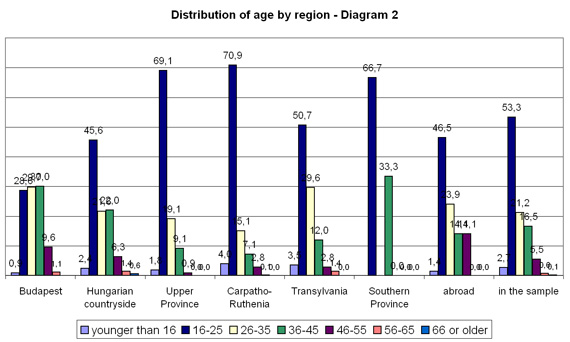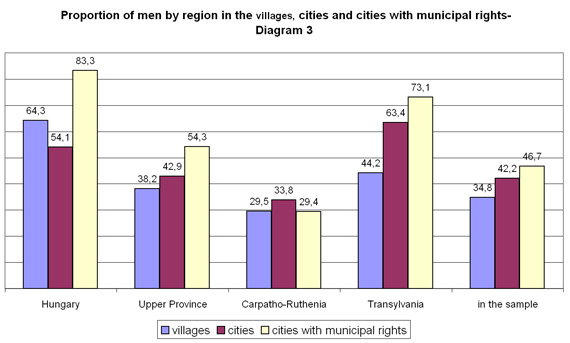Survivors in the Reflection of the Distribution of Regions
In the course of our analysis, we have identified the following regions: Budapest, Hungarian countryside, Upper Province (Felvidék), Carpatho-Ruthenia (Kárpátalja), Transylvania (Erdély), Southern Province (Délvidék), abroad. By the term "Hungarian countryside" we mean those territories of Trianon Hungary that are outside of Budapest. The "abroad" region is indicating those settlements that did not belong to Hungary in 1941.

Analysing the regional attributes of the survivors in the DEGOB protocols, the most well-marked characteristic is the dominance of the Carpatho-Ruthenian region. Almost half of the complete sample belongs to this region, which significantly exceeds the Carpatho-Ruthenian Jews' proportion in the Jewish population of 1941 Hungary, which was about 10 percent.
The other obvious fact is that if we take the Jewish population of only Trianon Hungary into consideration (in the diagram it is the joint population of Budapest and the countryside), then the Jews of the capital are exceedingly overrepresented. While in accordance with the 1941 census 46 percent of the Jews in Trianon Hungary lived in Budapest, the proportion in the DEGOB protocols in 73 percent. If we look at the data including the re-annexed territories too, then the proportion of the Budapest Jews still exceeds the same data of the 1941 census.[1]
We may conclude that the DEGOB protocols contain predominantly-in more than 80 percent-the stories and data of Carpatho-Ruthenian and Budapest Jews.
Distribution of gender by region
Proportion of gender in the different regions by type of settlement
Distribution of age by region

Diagram 2 shows that the patterns by age groups of the re-annexed territories-the Upper Province, Carpatho-Ruthenia, Transylvania[2] -are very similar to each other and the whole sample alike. Their common attributes are (1) the vast dominance of the 16-25-year generation and (2) the dramatically and continually decreasing proportions of the following generations.
The pattern of the regions "Hungarian countryside" and "abroad" are somewhat different from that. Although in both territories the generation of young adults (16-25 years) is dominating-albeit on a smaller scale than in the re-annexed territories-the situation is different at the following groups. In the case of those living in the countryside, the size of the age groups 26-35 and 36-45 is almost identical, while in the case of those from abroad this similarity shifts by an age group and the proportion of the 36-45 and 46-55 generations is similar.[3]
The largest deviation, however, may be observed with those living in Budapest: neither the dominance of the young adults, nor the "gradual" nature of the following generations manifest itself. Nine-tenths of those from the capital are distributed in an equal proportion in the three age groups between 16 and 45 years.
(The phenomenon might be explained by the fact that while in 1944, the overwhelming majority of the countryside Jews was deported to Auschwitz-Birkenau, Budapest Jewry avoided this fate. As a result, the Jewish community of the capital suffered significantly smaller losses and its structure of age groups was less damaged. While as a result of the selection system of Auschwitz-Birkenau [immediate murder of the young and middle-aged mothers together with their children, killing of the older middle-aged, children and the elderly] the age group of 16-25 is dominating among those from the countryside, in Budapest the age groups 16-25, 26-35 and 36-45 are in virtually equal proportion. Moreover, the next generation, i.e., the age group 46-55, is the far most populous here.)
We have to repeatedly note, however, that this explanation is formed by our historical knowledge; the analysed data do not bear probative force, since-as we emphasised in the introduction-the DEGOB collection is not representative, regarding either the survivors or the entirety of the deported.
Proportion of gender in the different regions by type of settlement

This diagram shows the proportion of men in the different regions by types of settlements. As we have seen in diagram 2 of the "Gender" menu point, the proportion of gender in the sample is varied by regions. However, since different types of settlements are typical of different regions, it is feasible that the variance observed in the gender distribution is in fact caused by the variance of the types of settlements. In other words, it is conceivable that the correlation is not between the gender and the regions, rather the gender and the type of settlements or the region and the type of settlements. The correlation between the gender distribution and the regions is further specified by the type of settlements as follows: "Southern Province" and "abroad" have been left out of the regions due to their small number of cases, and we fused "Budapest" and the "Hungarian countryside" into the region "Hungary".[4]
In the complete sample it is well observable that heading down on the "settlement slope" the correlation between the region and the gender distribution is decreasing: in the cities with municipal rights the proportion of men in the various regions largely differs; in the villages the difference is significant, though regionally smaller than in the case of the cities with municipal rights. Consequently the correlation between the region and gender remains when controlled for type of settlement; it is especially significant in the case of the cities with municipal rights.
Footnotes
[1] According to the census of 1941 the proportion of the Budapest Jews was 22-25 percent, including those living in the re-annexed territories (22 percent if we include the converts into the complete Jewish population, 25 percent if we do not). Az 1941. évi népszámlálás 4. Demográfiai és foglalkozási adatok törvényhatóságok szerint (Census of 1941. Part 4 : Demographical and Occupation Data by Municipal Authorities) Budapest, 1979.
[2] The Southern Province cannot be evaluated, since only three persons fall into this category.
[3] We have to note that only 71 people fall into this region. Fourteen percent of this figure is only 10 persons, and in the case of the sample consisting thousands of people, this is a very small number of cases.
[4] It would be more precise to call this region "Trianon Hungary", since the fusion of the two regions covers this territory, but to simplify the category system we use the term "Hungary".

